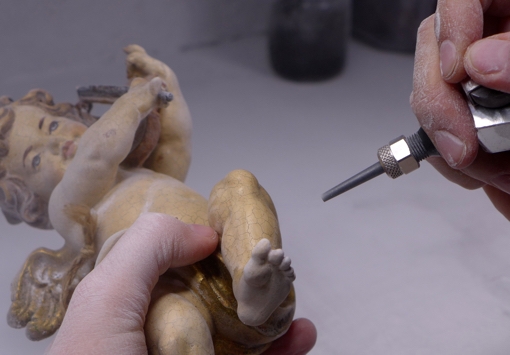[from: Johanna Ziegler M.A., Restauratorin, Kupferstich-Kabinett, Staatliche Kunstsammlungen Dresden]
The cleaning of sensitive, especially porous surfaces is often a challenge for restorers. Many well-known methods of dry cleaning are associated with mechanical stress of the surface of an object. So thorough cleaning often involves the risk of irreversibly altering the surface texture or even damaging the object.
Bert Jaçek (M.A.) devoted himself to this problem and developed, in collaboration with Deffner & Johann, the so-called soft particle blasting.
In this "gentle blasting", different particles such as cellulose or wheat starch powders are blasted onto the surface to be cleaned by means of compressed air.
In May, Deffner & Johann organized a workshop at the Institute for Art Technology and Conservation of the Germanic National Museum to present the procedure to preservation specialists of GNM as well as to some external participants.
After a theoretical introduction, the majority of the event was devoted to practical application. Under the guidance of Maren Dümmler (M.A.) and Bert Jaçek various blasting materials were tested at two cleaning stations. For many participants soft particle blasting on Paper or textiles was new and an unexperienced method of treatment.
In order to be able to familiarize with the handling of the devices and to assess the mode of action of the individual blasting media, a broad range of samples from a wide variety of materials was made available to participants. The cleaning effect and possible surface changes could be precisely assessed with stereomicroscope, UV light and Streiflicht. In addition, different eraser materials were available to compare the results of the soft particle radiation with those of the "conventional" dry cleaning.
In the course of the seminar participants were asked to test the treatment on sample from their field of research, and with which the techniques known to them were not satisfactory. It became clear that with the soft particle blasting, a very thorough and fast cleaning was achieved with most objects, without changing or damaging the surface.
The participants were especially surprised by the versatility of the materials for which the process is suitable. For example, wax and plastic objects, silk fabrics or paper and parchment degraded by mold, gypsum and gilded surfaces as well as wood have been successfully cleaned from dust and dirt.

A particular advantage was obtained with structured surfaces.
However, limitations of the method were also discussed amongst the participants. The size of the suction cabinet was considered a disadvantage. Loose layers color can be lost even in low air pressure and individualized surfaces have also been slightly modified with the softest blasting material.
Overall, soft particle cleaning was regarded a very effective and efficient method, delivery astonishing cleaning results.

